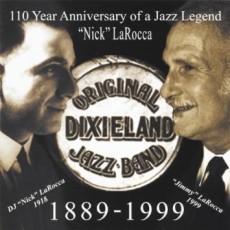
Daily Dose Of Jazz…
Nick LaRocca was born Dominic James LaRocca on April 11, 1889 in New Orleans, Louisiana to poor Sicilian immigrants. Attracted to the music of the brass bands in New Orleans as a child, he covertly taught himself to play the cornet against the wishes of his father who hoped his son would go into a more prestigious profession. From around 1910 through 1916 he was a regular member of Papa Jack Laine’s bands. A solid lead player with a strong lip allowed him to play long parades without let up or to play several gigs in a row on the same day.
In 1916 he joined Johnny Stein’s band to play a job in Chicago, Illinois, that subsequently became the Original Dixieland Jass Band and made their first commercially issued jazz recordings in New York City in 1917 that were hits, making them into celebrities. LaRocca led tours of England and the United States into the early 1920s, suffered a nervous breakdown. H retired from music until 1936 reuniting the ODJB for a successful tour and more recordings. He proclaimed that he and his band were the inventors of the now nationally popular swing music. Personality conflicts broke up the band again in 1937, and he again retired from music.
In the 1950s he wrote numerous vehement letters to newspapers, radio, and television shows, stating that he was the true and sole inventor of jazz music, damaging his credibility and provoking a backlash against him, his reputation and career. He donated his large collection of papers related to the O.D.J.B. to Tulane University in 1958 and worked with writer H.O. Brunn on the book The Story of the Original Dixieland Jass Band. Written during the Jim Crow era, he is acknowledge as an important figure, much in his own mind because he could not live with the thought that Negroes invented the music, in taking jazz from a regional style to international popularity, the leader of the most influential jazz band of the period from 1917 to 1921, and a good player in a very early jazz style on records.
Nick’s playing and recordings were an important early influence on such later jazz trumpeters as Red Nichols, Bix Beiderbecke and Phil Napoleon. His 1917 composition Tiger Rag is one of the most important and influential jazz standards of the twentieth century having some 136 cover versions by 1942 alone. It was covered by Louis Armstrong in several different versions throughout his career, while Duke Ellington, Art Tatum, Charlie Parker, The Mills Brothers, Frank Sinatra, Benny Goodman, Les Paul and Kid Ory also recorded important and influential cover versions of the jazz standard.
In 2006, his 1917 recording of Darktown Strutters Ball with the Original Dixieland Jass Band was inducted into the Grammy Hall of Fame. Cornetist Nick LaRocca, who was part of what is generally regarded as the first recorded jazz band, releasing the first jazz recording Livery Stable Blues in 1917, passed away on February 22, 1961 in New Orleans.
![]()
More Posts: cornet


